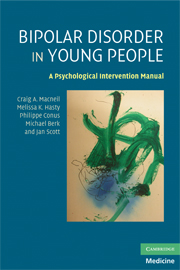Book contents
- Frontmatter
- Contents
- Preface
- Acknowledgements
- Introduction
- 1 Bipolar disorder
- 2 Assessment and engagement
- 3 Insight, adaptation, and functional recovery
- 4 Medication adherence
- 5 Cognitive behavioral therapy interventions
- 6 Social rhythm regulation
- 7 Relationship issues and family work
- 8 Alcohol, substance abuse, and other comorbid disorders
- 9 Identifying early warning signs, preventing relapse, and termination of therapy
- Appendices
- References
- Index
Appendices
Published online by Cambridge University Press: 06 July 2010
- Frontmatter
- Contents
- Preface
- Acknowledgements
- Introduction
- 1 Bipolar disorder
- 2 Assessment and engagement
- 3 Insight, adaptation, and functional recovery
- 4 Medication adherence
- 5 Cognitive behavioral therapy interventions
- 6 Social rhythm regulation
- 7 Relationship issues and family work
- 8 Alcohol, substance abuse, and other comorbid disorders
- 9 Identifying early warning signs, preventing relapse, and termination of therapy
- Appendices
- References
- Index
Summary
What is bipolar disorder?
Bipolar disorder, also known as manic depression, affects at least 1 or 2 in every 100 people.
Bipolar disorder is a mood disorder involving extreme changes in emotion. While anyone can experience “ups and downs,” bipolar disorder can result in a person at times feeling extremely happy, excitable, and invincible, and at other times feeling irritable, miserable, or even suicidal. Bipolar disorder can also affect the way people think and behave, can affect work, study, and relationships, and can result in hospitalization. It is also a disorder that can keep returning if not treated properly. However, it can also be managed very effectively, with evidence showing that getting help earlier can result in better outcomes.
Diagnosis should only be made by a health professional, but symptoms can include the following:
Symptoms of mania
Feeling “high,” full of energy, or easily annoyed for at least 7 days, and:
Feeling “driven” to do things, which may feel out of control at times.
Reckless or impulsive behavior and doing things you usually wouldn't, e.g. spending excessively, being more promiscuous, making decisions without thinking them through, or using drugs or alcohol excessively.
Finding it very hard to concentrate or focus on one task, and not being able to finish tasks.
Feeling physically jumpy.
Talking very fast.
Feeling like your thoughts are going very fast, or jumping from one subject to another.
Feeling like you don't need any sleep.
Increased sexual drive.
Increased self-confidence.
Feeling you have special abilities or talents that no-one else has.
- Type
- Chapter
- Information
- Bipolar Disorder in Young PeopleA Psychological Intervention Manual, pp. 147 - 164Publisher: Cambridge University PressPrint publication year: 2009



